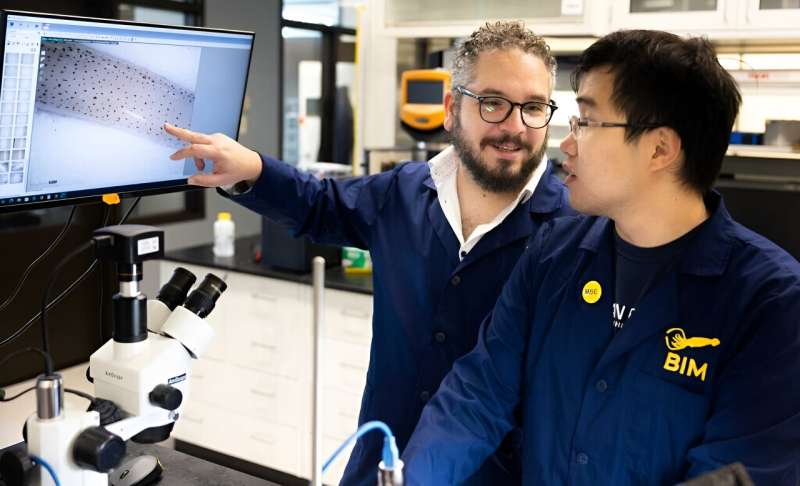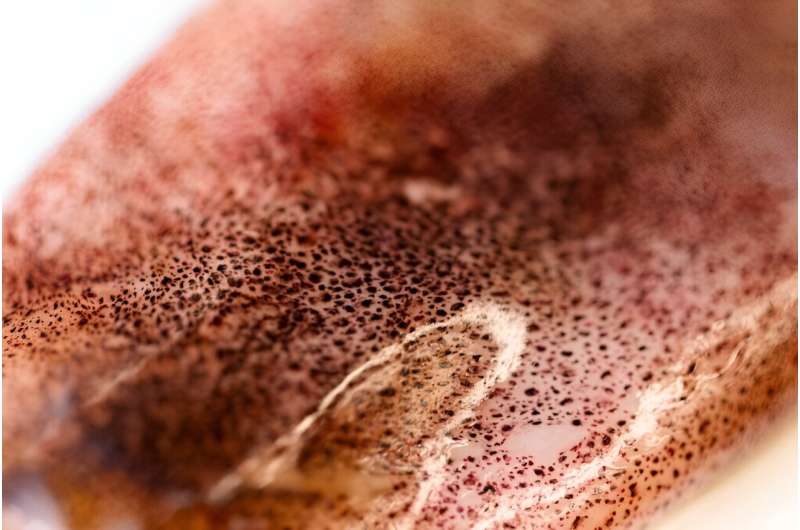Inspired by squids and octopi, a new screen stores and displays encrypted images without electronics
A flexible screen inspired in part by squid can store and display encrypted images like a computer—using magnetic fields rather than electronics. The research is reported in Advanced Materials by University of Michigan engineers.
“It’s one of the first times where mechanical materials use magnetic fields for system-level encryption, information processing and computing. And unlike some earlier mechanical computers, this device can wrap around your wrist,” said Joerg Lahann, the Wolfgang Pauli Collegiate Professor of Chemical Engineering and co-corresponding author of the study.
The researchers’ screen could be used wherever light and power sources are cumbersome or undesirable, including clothing, stickers, ID badges, barcodes and e-book readers. A single screen can reveal an image for everyone to see when placed near a standard magnet or a private encrypted image when placed over a complex array of magnets that acts like an encryption key.
“This device can be programmed to show specific information only when the right keys are provided. And there is no code or electronics to be hacked,” said Abdon Pena-Francesch, U-M assistant professor of materials science and engineering and co-corresponding author. “This could also be used for color-changing surfaces, for example, on camouflaged robots.”
[embedded content]
Shaking the screen erases the display—like an Etch-A-Sketch—except the image is encoded in the magnetic properties of beads inside the screen. It returns when the display is exposed to the magnetic field again.
The beads act like pixels by flipping between orange and white hemispheres. The orange halves of the beads contain microscopic magnetic particles that allow them to rotate up or down when exposed to a magnetic field, providing the color contrast needed to display an image.
Exposing the pixels to a magnet will program them to show either white or orange in either a pulling or pushing magnetic field—a state referred to as their polarization. For some pixels made with iron oxide magnetic particles, the polarization can be changed with relatively weak magnetic fields. But the polarization of pixels that also include neodymium particles is harder to change—a strong magnetic pulse is required.

Holding the screen over a grid of magnets with different strengths and orientations can selectively change the polarization in some parts of the screen, causing some pixels to flip white and others to flip orange under the same magnetic field orientation. This is how an image is encoded.
Then, the image can be displayed under any weak magnetic field, including a regular magnet. But because iron oxide particles can be reprogrammed with relatively weaker fields, private images can be displayed with a second magnetic grid that selectively rewrites how some areas of the screen flip. When returned to the standard magnet, the iron oxide pixels revert back to their original polarization to show the public image.
Several private images can be displayed from a single public image, each with a unique key. The decoding keys can also be programmed to only work with specific encoding keys for extra security.

The team decided on the screen’s resolution by studying squids and octopi, which change color by expanding and contracting pigment sacs in their skin.
“If you make the beads too small, the changes in color become too small to see,” said Zane Zhang, U-M doctoral student in materials science and engineering and the study’s first author. “The squid’s pigment sacs have optimized size and distribution to give high contrast, so we adapted our device’s pixels to match their size.”
More information:
Zenghao Zhang et al, Janus Swarm Metamaterials for Information Display, Memory, and Encryption, Advanced Materials (2024). DOI: 10.1002/adma.202406149
University of Michigan
Citation:
Inspired by squids and octopi, a new screen stores and displays encrypted images without electronics (2024, September 16)
retrieved 17 September 2024
from https://techxplore.com/news/2024-09-squids-octopi-screen-displays-encrypted.html
This document is subject to copyright. Apart from any fair dealing for the purpose of private study or research, no
part may be reproduced without the written permission. The content is provided for information purposes only.

Comments are closed